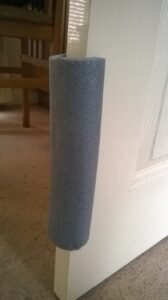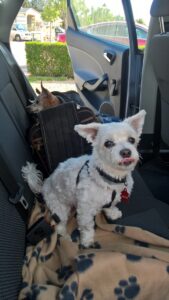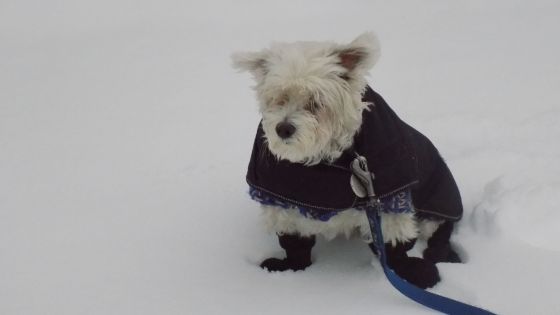Over time your dog’s vision may fade, and mobility issues can make it harder to navigate around the house and outside. Today is the perfect day to start thinking about, how you can make your home and surroundings more senior dog friendly.
From keeping the furniture where it is and floors free of clutter, to buying a ramp and putting out more water bowls, these are just a few ways to adapt your home and surroundings to your dog’s changing needs.
Dog Safety in the Home
Keep the Furniture Where It Is
Your dog will already be used to the layout of the house, so don’t confuse things if he or she is experiencing some vision loss. It’s stressful enough, she doesn’t need to be banging into a table that was never there before. If you need a change, how about throw pillows and accessories?
Elevate Food and Water Bowls

One reason your senior dog may not be eating and drinking as well as she used to, is because she’s finding it harder to reach down to her bowls. Elevating them slightly may make a big difference. You can go the DIY route and put them on an overturned casserole dish like I did, or buy adjustable feeders.
There is an issue when it comes to bloat and raised feeders, which you will find more information about in the sources section at the bottom of this post.
If raising the bowls makes no difference, please be sure to take her to the vet as soon as possible. There could very well be a medical explanation, and the sooner it’s caught the sooner it can be treated or at least managed.
Keep Floors Free of Clutter
A blind dog, or one with mobility issues can easily trip and hurt themselves on things left on the floor. Keep them clutter free and prevent an accident, and another vet bill from happening.
Keep Garbage Cans Out of Reach
Keep your dog safe by putting garbage cans out of reach. If you have no place to hide it, buy one your dog cannot possibly get into, no matter how hard he tries.
Put Padding on Handles and Knobs
Get down on the floor at your dog’s level and take note of all handles, knobs or any other sharp objects that may be sticking out. Don’t worry, you don’t have to change or remove all that hardware, just wrap it in bubble wrap or fabric so your dog won’t get hurt if he knocks into it.
If you scroll up to the elevate dog bowls section, you’ll notice on the right hand side something that looks like white material. That’s what I used to wrap around the handle that was at Red’s eye level when she drank. I didn’t want her to hit her head (she was blind), because it was literally the only place to put her bowl in the kitchen.
Keep Hazardous Items Out of Reach
Cleaning products, toxic plants, medications and cleaning supplies should all be kept out of reach. Your dog may never have bothered with them before, but an illness such as canine cognitive dysfunction (dementia) which causes confusion may change that.
Baby Gates
Arthritis and loss of vision make stairs a safety issue, so install gates at the top and bottom of all staircases.
Cover Slippery Floors
Slipping and sliding and trouble getting her footing, are all reasons to cover up your slippery floors. A few area rugs, yoga mats or interlocking rubber mats will make it safer for your old dog to get around. For more tips on how to help, check out “How to Stop Your Old Dog Slipping on the Floor”
Dog Ramps and Pet Stairs
If your dog is having trouble jumping onto the couch or bed, or getting in and out of the car has become a struggle, a dog ramp and pet stairs are the answer.
When looking to buy stairs, be mindful of how far they stick out in a house with a blind dog. I’m not saying don’t buy them, just keep it in mind.
Which is better, stairs or a ramp? It depends…
Dog ramp
- Good for cars, boats and getting on and off the bed
- They come in a wide variety of styles – telescoping, folding, rolling, free standing, platform at the top
- Make sure the ramp is sturdy enough to take the weight of your dog, no buckling in the middle when he walks on it
- If your dog is unsteady, raised sides are an important safety feature
- How steep is the incline? A longer more gradual incline is easier to use
- Is it covered in a comfortable, anti-slip material?
- How secure is it against the car, boat or bed? Can it slip and cause your dog to fall?
- If you’ll be using it outdoors, think weather resistance
- Where you intend to store it and how much room you have, will influence the type you buy
- There are ramps to suit most budgets, so with some online research you should manage to find the best one at a good price
If you don’t find one that suits your needs, you could go the DIY route like my husband and many other senior dog parents have done.
Pet stairs
- Look at the rise of each step, meaning how high your dog will have to step to reach the next one
- Depth of each step is also important in terms of comfort and ease of use
- Stairs take up less room in the house than a ramp, so they work well for getting on and off the couch
- Some pet stairs like the Pet Loader for example, are for the car
- For dogs with severe arthritis or other joint issues, steps may be too difficult to use. In those cases, a ramp with a very gradual incline may be your best option
How to Teach Your Dog to Use a Ramp
Some dogs will take to it right away, others need guidance. I wrote this with a scared dog in mind.
Step one
Put the ramp flat on the floor and let your dog check it out. If she seems fine give her a treat. If she’s not food motivated, praise or a favorite toy work too! Do this a couple of times (more if needed), until you know she’s not bothered being around it. Don’t reward her if she seems fearful, because you’ll be reinforcing that feeling.
Step two
Set the ramp up, put a treat at the very bottom so she doesn’t have to put a paw on it to reach. If she’s fine doing that, take another treat and put it slightly further up, then another further up and so on. Don’t move the treat higher until she’s comfortable at the previous point.
Once she’s gotten to the top, you can lay a trail of treats from the bottom to the top and let her eat her way up.
When she’s happy at that incline gradually increase it to the incline you’ll be using, and repeat the steps if necessary.
Cover Door edges, Chair and Table Legs

Things like pipe insulation slit down the middle or bubble wrap are great options for covering door edges, chair legs, and table legs and corners. This is a picture of how I covered the doors in my house.
Cover or Hide Wires and Cables
This is good practice for dogs of any age. It’s easy to trip over an exposed cable, and puppies can make them their next favorite chew toy.
Does Her Bed Suit Her Changing Needs
That huge round bed your dog used to love climbing into may have become challenging recently. What about the other bed she’s been using for years? Any stuffing left in that one!
Finding one more suitable and comfortable can be a case of trial and error, so when you’re looking keep these factors in mind:
- How easy is it to get in and out of? A dog having trouble with steps for example, will benefit from a bed with a low front
- Is the bottom well padded? The extra support will help
- It’s possible your dog will have accidents, so look for one with a removable cover for washing. If the one you like isn’t washable, buy a waterproof cover or put pee pads on top
- Raised sides will give your dog something to rest against
- An orthopedic bed can offer more support than a basic dog bed. Some even contain magnets that claim to help with arthritis and other joint issues
Helpful tips:
- Put more than one bed around the house so your dog doesn’t have far to go
- A blanket on every bed will provide extra padding and warmth if she’s feeling the cold more these days
Night Lights
Adding some light for night time will make it easier for your vision impaired dog to get around. Did you know it can also help with sundowner’s which is a symptom of dementia?
Install a Nanny Cam
So many great tips for making your home safe for an old dog, but what happens when you’re not home? A nanny cam allows you to check on him, see what he does when he’s alone, what he plays with etc… There may be some safety issues you need to address that you weren’t aware of before.
Holiday Safety
Whether it’s Halloween, Christmas, Hanukkah or Easter, here are tips that will keep your senior dog safe.
Candles
Lit pumpkins or candles are an accident waiting to happen. Keep them out of reach so your dog doesn’t accidentally knock them over.
Keep Your Dog in the House
With guests coming and going, the noise and activity will not only make an anxious dog’s anxiety worse, he could accidently get out the door when no one is watching. Don’t leave him in the yard because someone could snatch him, sadly not as uncommon as we would like. Keep him safe by putting him in another room with a comfy bed, blanket, favorite toy, water and some dog calming music to help him relax. Either close the door completely or use a baby gate so he can see what’s going on.
Lights and Decorations
High up and out of reach so your dog doesn’t decide they’d make a nice chew toy.
Food and Treats
Feeding your dog from the table is a bad idea any time of year, but particularly over the holidays. How many people are slipping him food on the side, how much and what type?
Whether it’s chicken or ham, jelly donuts or latkes, too much rich and fatty foods can cause pancreatitis, a potentially life-threatening condition. That one bout can turn into a chronic condition that will have to be managed throughout your dog’s life.
Chicken bones can get stuck or splinter and cause internal damage
Keep bags of candy and chocolate out of reach, and pick up anything that drops right away. Not only are they toxic but a choking hazard as well.
Play Dreidel on the Table
Dreidel, a 4-sided spinning top used to play a game of the same name on the holiday called Hannukah, are a choking hazard. Play on the table out of reach.
Wrapping and Gifts
Gift wrap, ribbons, bows and plastic packaging make the most fun toys for dogs, but present some dangers. Include your dog in the festivities by wrapping his toys, letting him rip the paper, then throw it out while he plays with what’s appropriate.
Be mindful of your kids’ gifts lying around because your dog can easily chew them, swallow a small piece or get it stuck in his throat.
Costumes
Some dogs are more easy going about this than others, so if yours is uncomfortable take it off. If he’s happy to comply, make sure it fits properly so it doesn’t restrict breathing, or have loose threads or beading she can chew off and choke on.
Trees and Plants
- Keep plants like poinsettias, mistletoe and holly out of reach
- Anchor your tree so it doesn’t fall
- Fence it off so they can’t get to the tree water which can contain fertilizers, bacteria or even aspirin
- Close the door to the room where your tree is when you’re out
Keep Emergency Numbers Handy
Poison control hotlines and 24 emergency vets are numbers that need to be in your phone, and hanging in a central location in your home. The sooner you deal with an emergency situation, the more likely you will have a happy outcome.
ASPCA Animal Poison Control Center
Dog Safety Outside the Home
Car Safety

Whether it’s a crate, pet carrier or seat belt, you need to keep your old dog safe in the car. A dog running loose can cause an accident, and he could get seriously hurt if you have to brake suddenly.
I’m sorry I wish the picture was clearer, but here’s Jack (the white dog) wearing his seat belt, and Red behind him in her travel bag.
Keep Your Senior Dog Out of the Garage
Tools, toxic chemicals and anti-freeze are too dangerous for any dog to be around, so keep the door closed and your pup safe.
Sturdy Fencing
Walk the perimeter and fix any holes and broken fencing you come across. Your dog may be an escape artist and be gone the next time you check on him.
Pesticides and Lawn Care
Bug killer, rat poison, insecticides and other products we use to keep our lawns green and lush are dangerous to dogs. Use them according to manufacturer’s guidelines and store them out of reach. As much as possible opt for natural and pet safe.
Tidy Up Your Yard
Gardening tools and holes in the grass present a real danger to dogs of all ages, and seniors in particular. Put tools away or out of reach, and fill any holes your dog could stumble into and sprain or break a leg.
Stroller

As far as I’m concerned, a dog stroller is one of the great inventions and there are so many ways it will help you keep your old dog safe. This is my dog Red in her stroller, and this was a life changer for all of us.
- In large crowds, especially if you have a small dog, it will prevent him getting stepped on and hurt
- If he’s become more anxious, a stroller will help him feel more secure, especially if you zip up the sun roof and create a den
- Exercise is important for old dogs, but many can’t walk as long as they used to. A stroller means he can still enjoy a walk with as many breaks as he needs. No more going home early or carrying him.
- An old dog with health issues or any dog recovering from surgery can still get the fresh air and mental stimulation they need, but within the safety of a dog stroller
Outside in the Summer
- Too long in the hot sun can cause heat stroke, and if not caught quickly can cause death
- Provide a shady spot your dog can escape the sun, whether it’s a bush or a garden umbrella it doesn’t matter
- Make sure your dog always has access to water when he’s playing in the yard, and bring some with you on walks
- Pavement and sand can get hot enough to burn his paws. Once again provide shade, or walk during cooler parts of the day
- Always supervise your dog around the pool. If it’s not fenced in and you’re only running in the house for a minute, bring him with you. You get distracted, someone calls and the next thing you know an hour has gone by and your dog has drowned. Sorry, but it’s not an unrealistic scenario.
Outside in the winter

This is a picture of Jack. We took him to Toronto one winter, and not being used to snow (he was from Florida), you can see how unimpressed he was. He’s wearing a thick sweater under his waterproof coat and booties.
- Older dogs feel the cold a lot more than younger ones, so protect him from the elements with a sweater and a coat
- Don’t leave him unattended in deep, soft snow. He could struggle which would put stress on an already weak heart (if that’s an issue), cause anxiety to skyrocket or he could literally get lost in a pile of snow
- Salt is painful on dog’s paws, poisonous if ingested and the snow is freezing, so booties are a great solution. Have a dog that refuses to wear them? Paw wax works too
What changes have you made to your home and surroundings to keep your senior dog safe? Sharing helps others so leave your comments below.
If you’re looking for a community of senior dog parents, a place where you can find helpful tips, support and people who “get it” please join my FB group Senior Dog Care Club
I’m excited to announce my new Senior Dog Care Support Service.
I offer 1:1 support on everything from health & wellness advice and training tips, to preparing to say goodbye and grief counselling. You can find details on all the packages I offer by visiting the Senior Dog Care Support Service page. If you have any questions or would like to book your FREE 15 minute chat, please email hpearson141@gmail.com
I’ve been rescuing and caring for senior dogs since 2009. From vision and hearing loss to obesity, dementia, kidney disease, liver issues, cardiac problems, Cushing’s, mobility challenges and more, you could say I’ve dealt with and learned a lot! In addition to my hands on experience, I’ve taken many courses and earned several qualifications to keep learning how to help senior dogs and they include: Senior Dog Enrichment, Understanding Canine Anxiety, Care of the Senior Pet and I’m a Certified Pet Loss Specialist.
